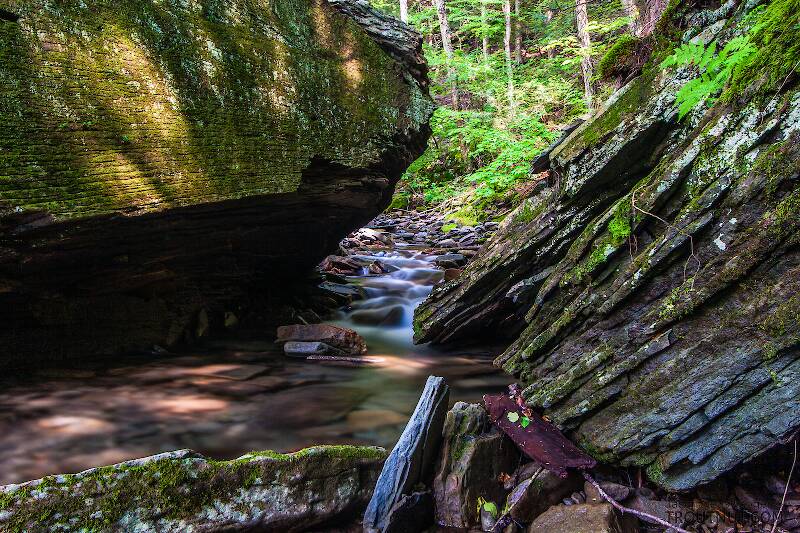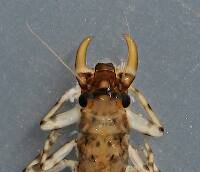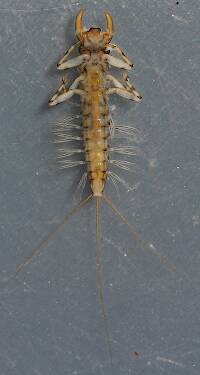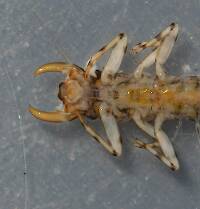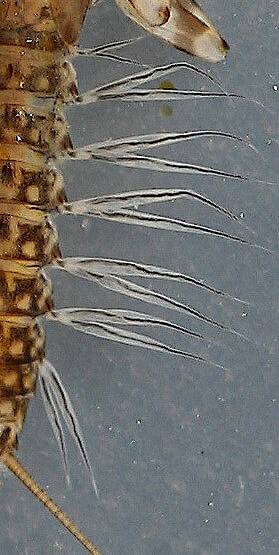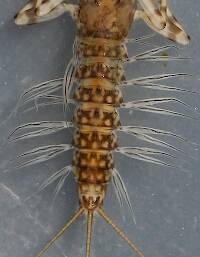
Blue-winged Olives
Baetis
Tiny Baetis mayflies are perhaps the most commonly encountered and imitated by anglers on all American trout streams due to their great abundance, widespread distribution, and trout-friendly emergence habits.
Featured on the forum

I was not fishing, but happened to be at an unrelated social event on a hill above this tiny creek (which I never even saw) when this stonefly flew by me. I assume it came from there. Some key characteristics are tricky to follow, but process of elimination ultimately led me to Sweltsa borealis. It is reassuringly similar to this specimen posted by Bob Newell years ago. It is also so strikingly similar to this nymph from the same river system that I'm comfortable identifying that nymph from this adult. I was especially pleased with the closeup photo of four mites parasitizing this one.

Troutnut is a project started in 2003 by salmonid ecologist Jason "Troutnut" Neuswanger to help anglers and
fly tyers unabashedly embrace the entomological side of the sport. Learn more about Troutnut or
support the project for an enhanced experience here.
Xavier_Carp
Posts: 13
Posts: 13
Xavier_Carp on Feb 21, 2008February 21st, 2008, 4:38 am EST
Hi guys, I have a question, does anyone collects bugs? if so how do you preserve aquatic insect larvae???
Thanks
Thanks
Konchu on Feb 21, 2008February 21st, 2008, 5:27 am EST
Here is some info on collecting and preservation of mayflies. These instructions will work for most other groups, too. Mayflies are delicate and need to be handled separately from other aquatic specimens. Other kinds of bugs have special handling, too. I'll sometimes carry some of the really soft things from the field alive and drop them into boiling water in a foam cup for a few seconds before transferring them to EtOH. A small, immersion heater will usually do the trick, plugged into an adapter that is plugged into the cig lighter of my vehicle.
http://mypage.iu.edu/~lmjacobu/collecting.html
"Collection fluid" usually refers to ethanol (EtOH). I recommend collecting into a solution of 90% EtOH/10% water. After an hour, or a little more, I'll drain off the solution and add more of the same concentration. I'll do this a few times until the liquid stops turning yellow. Finally, I'll put the specimens into a solution of 70% EtOH/30% water. However, if I am going to try to extract DNA from the specimens (ever), I'll collect into 100% (200 proof) EtOH and continue changes, using 100% each time. This often will leave specimens brittle, and sometimes they will extrude tissue. A final resting place of 70% is the best for medium-term storage and handling. Keeping specimens in alcohol in a freezer will extend their useful "life"time.
Best of luck.
http://mypage.iu.edu/~lmjacobu/collecting.html
"Collection fluid" usually refers to ethanol (EtOH). I recommend collecting into a solution of 90% EtOH/10% water. After an hour, or a little more, I'll drain off the solution and add more of the same concentration. I'll do this a few times until the liquid stops turning yellow. Finally, I'll put the specimens into a solution of 70% EtOH/30% water. However, if I am going to try to extract DNA from the specimens (ever), I'll collect into 100% (200 proof) EtOH and continue changes, using 100% each time. This often will leave specimens brittle, and sometimes they will extrude tissue. A final resting place of 70% is the best for medium-term storage and handling. Keeping specimens in alcohol in a freezer will extend their useful "life"time.
Best of luck.
Shawnny3 on Feb 21, 2008February 21st, 2008, 3:03 pm EST
I'll sometimes carry some of the really soft things from the field alive and drop them into boiling water in a foam cup for a few seconds before transferring them to EtOH.
You're a sick man, Konchu.
-Shawn
Jewelry-Quality Artistic Salmon Flies, by Shawn Davis
www.davisflydesigns.com
www.davisflydesigns.com
Martinlf on Feb 22, 2008February 22nd, 2008, 9:23 am EST
Oh, and you can say this after digging some of those holes in the cornfield for me, Shawn?
"He spread them a yard and a half. 'And every one that got away is this big.'"
--Fred Chappell
--Fred Chappell
Xavier_Carp
Posts: 13
Posts: 13
Xavier_Carp on Feb 22, 2008February 22nd, 2008, 12:44 pm EST
Konchu, thanks alot I'll do that, I really enjoy studying my bugs hehehe
Shawnny3 on Feb 23, 2008February 23rd, 2008, 12:42 am EST
Louis, that was completely different. Comparing insects with bait fishermen - apples and oranges.
-Shawn
-Shawn
Jewelry-Quality Artistic Salmon Flies, by Shawn Davis
www.davisflydesigns.com
www.davisflydesigns.com
Quick Reply
Related Discussions
Topic
Replies
Last Reply
Re: Differentiation b/t Gomphidae and Cordulegastridae
In the Insect Order Odonata-Anisoptera by DMM
In the Insect Order Odonata-Anisoptera by DMM
1
Nov 29, 2006
by Troutnut
by Troutnut
3
Feb 12, 2009
by Creno
by Creno
2
Sep 24, 2006
by Troutnut
by Troutnut
0
Jul 10, 2006
by Troutnut
by Troutnut

